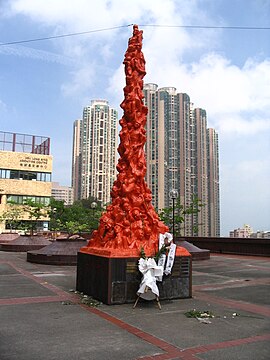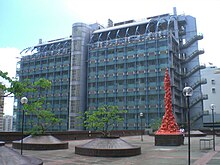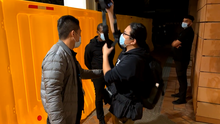Pillar of Shame
| Pillar of Shame | |
|---|---|
 The Hong Kong Pillar of Shame |
Pillar of Shame is a series of sculptures by Danish artist Jens Galschiøt memorialising the loss of life during specific events or caused by specific circumstances in history. Each sculpture is an eight metres (26 ft) tall statue of bronze, copper or concrete.
The first sculpture was inaugurated at the NGO Forum of the
Symbolism
According to Galschiøt,[3] the sculptures remind people of a shameful event which must never recur. The torn and twisted bodies of the sculpture symbolize the degradation, devaluation and lack of respect for the individual. The black colour symbolises grief and loss and the sculpture, which represents the victims, expresses the pain and the despair of the event. It can be used by both sides in complicated conflict situations, where it can be difficult to point out the guilty party.
Pillar of Shame in Hong Kong


The Pillar of Shame (
The Pillar was first exhibited at the Candlelight Vigil in commemoration of the eighth anniversary of the
During the following months, the Pillar was exhibited at the following universities:
- Chinese University of Hong Kong from 28 September 1997
- Lingnan Collegefrom 2 November 1997
- Hong Kong Baptist University from 29 November 1997
- Hong Kong University of Science and Technology from 23 January 1998
- Hong Kong Polytechnic University from 1 March 1998
- City University of Hong Kong from 29 March 1998.
On 31 May 1998, the ninth anniversary of the Tiananmen Square protests, the sculpture was returned to Victoria Park where a candlelit vigil was held. On the morning before the vigil, a self-professed artist splashed two buckets of red paint onto the Pillar, claiming that "the blood of people is also my blood."[4]
On 24 and 25 September 1998,
On 30 April 2008, the Pillar of Shame was painted orange as part of the project
Dispute over potential removal in October 2021
In October 2021 the University of Hong Kong, represented by law firm Mayer Brown, formally requested that the statue be removed, although they did not cite any specific reason for the request.[8] The university released a statement claiming that the statue belonged to "an external organisation" which had publicly announced its disbandment – referring to the Hong Kong Alliance – and that it had written to the Alliance based on the "latest risk assessment and legal advice" to request the removal.[9] Galschiøt said that he was "shocked" when hearing the news about the potential removal and that he, who considered himself as remaining the owner of the statue, had never been contacted by the university in the matter.[9] He urged HKU to allow the statue to remain, saying that it would help the world to remember the peaceful demonstrators who "were killed for expressing their wishes for political participation".[10][11] He said that he hoped to "be able to transport the sculpture out of Hong Kong under orderly conditions", and that any damage to the statue would be the university's responsibility.[12] On 15 October, Mayer Brown announced that it would no longer be representing the university in the matter of the statue, while retaining it as a client.[13] The move came days after intense pressure, including by an open letter penned by 28 civil society groups, as well as by overseas intellectuals.[14]
Removal of the statue in December 2021


According to media accounts in Hong Kong, the University of Hong Kong blockaded the Pillar of Shame and the surrounding area on 22 December 2021. Near midnight, the university sent security guards and workers to the site,
Following the removal, Galschiøt received over 40 inquiries about making copies of the statue. He decided to relinquish his right to commercial exclusivity, so that anyone can make a copy, provided that all profits are given to the Hong Kong pro-democracy movement.[25] In May 2022, a replica was installed at the University of Oslo, scheduled to be on display for about a month.[26]
In May 2023, the Pillar of Shame was seized from storage at the Kadoorie Centre by Hong Kong's National Security Department, reportedly to be used as evidence in a case of subversion of state power.[27]
Exhibition outside the European Parliament in March 2024
In March of 2024 one of several smaller scale models Galschiøt made in the 90s along with "forbidden art" deemed subversive by China and Hong Kong was put on exhibition outside the European Parliament during debates about:
- China Extensive Human Rights violations.
- Hong Kong’s Democratic Derailment.
- Persecution of Dissidents inside Europe.
- China's censorship inside Europe.
- Political Art Censorship in China and Hong Kong as a way of oppression.
- What role do Western Auction Houses play in political art censorship in Hong Kong?
- Can the Western Art Market accept that its auction houses perform political art censorship in Hong Kong?
- Is Hong Kong’s Art Market about to Collapse? If so, will it create a Domino Effect?[28][29]
Other Pillars of Shame
Other Pillars have been erected in the following locations:
- FAO Summit, depicting the deaths caused worldwide by hunger due to the uneven distribution of the world's resources.[30]
- December 1997 massacre of 45 members of the civil society group Las Abejas in Acteal.[31]
- A fifth Pillar of Shame was planned in Berlin, Germany, in homage to the victims of the Nazi regime. Due to various problems, the artist had to cancel the project.[2]
- A replica of the Pillar of Shame in Hong Kong was displayed on the forecourt of the Axel Springer Building in Berlin for one month,[34] in response to the removal of the statue in Hong Kong.[35]
A pile of over 16,000 shoes, each pair representing a victim of the 1995 Srebrenica massacre, is placed in front of the Brandenburg Gate in Berlin, Sunday 11 July 2010. The shoes were collected to make The Pillar of Shame by German activist Phillip Ruch's monument to Srebrenica.[36]
Gallery
-
The original Pillar of Shame
-
Close up of Pillar
-
English writing on the base
-
Chinese writing on the base meaning "June 4 Massacre"
-
Pillar of Shame sculpture dedicated to the2022 Russian invasion of Ukraine
See also
References
- ^ The Pillar of Shame in Berlin. Aidoh.dk. Retrieved on 17 January 2015.
- ^ a b The Pillar of Shame in Berlin – a Memorial for the Victims of Nazi Terror. Aidoh.dk. Retrieved on 16 November 2010.
- ^ The Pillar of Shame — detailed description of the art happening that is being carried out by Jens Galschiot, Denmark.
- ^ Chu, Prisca & Luk, Mandy (5 June 1999). Artist adds `personal touch' to Pillar, The Standard
- ^ Lam Wan Rhonda (17 May 1999). "Students to erect Pillar of Shame permanently", The Standard
- ^ a b "Pillar of Shame still without a home"". South China Morning Post. 3 June 1999. Retrieved 11 October 2022.
- ^ Staff reporter and agencies (6 June 1999) "Campus war of words over pillar", The Standard
- ^ Riordan, Primrose; Badkar, Mamta (8 October 2021). "Hong Kong university hires US law firm to seek Tiananmen statue's removal". Financial Times. Archived from the original on 11 December 2022. Retrieved 9 October 2021.
- ^ a b Chau, Candice (8 October 2021). "University of Hong Kong orders removal of Tiananmen Massacre statue after 24 years, artist 'shocked'". Hong Kong Free Press. Retrieved 13 October 2021.
- ^ Grundy, Tom (5 October 2021). "'Sacrilege': Artist urges University of Hong Kong not to remove Tiananmen Massacre statue". Hong Kong Free Press. Retrieved 10 October 2021.
- ^ Leung, Christy (8 October 2021). "University of Hong Kong demands removal of sculpture honouring victims of Tiananmen Square crackdown". South China Morning Post. Retrieved 13 October 2021.
- ^ Mahtani, Shibani (13 October 2021). "Hong Kong's 'Pillar of Shame' sculpture for Tiananmen victims faces removal". The Washington Post. Retrieved 14 October 2021.
- ^ Grundy, Tom (16 October 2021). "US law firm Mayer Brown will not longer represent University of Hong Kong on removing Tiananmen Massacre statue". Hong Kong Free Press. Retrieved 5 October 2021.
- ^ Griffiths, James (13 October 2021). "Artist fights to preserve Pillar of Shame Tiananmen memorial as Hong Kong University demands removal". The Globe and Mail. Retrieved 15 October 2021.
- ^ "港大拆國殤之柱? 校方突用圍板、白布封起 帶頭盔工程人員到場". HK01. 22 December 2021. Retrieved 22 December 2021.
- ^ "國殤之柱遭白幕圍封 吊臂車駛入港大 疑為移走工程作準備". 東方日報. 22 December 2021. Retrieved 22 December 2021.
- ^ "Hong Kong memorial to victims of Tiananmen Square dismantled". France 24. 23 December 2021. Retrieved 14 January 2022.
- ^ "港大深夜突襲圍封國殤之柱 保安:不要影、不清楚、不知道". YouTube.
- ^ Grundy, Tom (22 December 2021). "University of Hong Kong removes Tiananmen Massacre monument in dead of night". Hong Kong Free Press HKFP. Retrieved 22 December 2021.
- ^ "'Pillar of Shame' removed from HKU campus". The Standard.
- ^ "Pillar of Shame: Hong Kong's Tiananmen Square statue removed". BBC News. 23 December 2021. Retrieved 23 December 2021.
- ^ "RTHK News More June 4 artwork removed from universities". Radio Television Hong Kong.
- ^ "Two more Hong Kong universities tear down Tiananmen Massacre monuments in early hours of Fri". Hong Kong Free Press.
- ^ "Two Hong Kong universities remove Tiananmen artworks after Pillar of Shame dismantled". The Guardian.
- ^ Hagemann-Nielsen, Frederik (2 January 2022). "Dansk kunstner bag fjernet skulptur i Hongkong ophæver copyrighten efter storm af henvendelser" [Danish artist behind removed sculpture in Hongkong relinquish copyright after storm of inquiries]. DR (in Danish). Retrieved 3 January 2022.
- ^ "Replica of Hong Kong's 'Pillar of Shame' unveiled in Norway". CNN. 26 May 2022.
- ^ "Hong Kong national security police seize 'Pillar of Shame' statue in connection with subversion case". 5 May 2023. Retrieved 14 May 2023.
- ^ https://edition.cnn.com/2024/03/20/style/pillar-of-shame-european-parliament-intl-hnk/index.html
- ^ https://galschiot.com/en/work/2024eu_pillar
- ^ The Pillar of Shame in Rome – at the FAO Summit, 1996. Aidoh.dk. Retrieved on 16 November 2010.
- ^ The Pillar of Shame in Mexico, 1999 – A memorial of the Acteal massacre. Aidoh.dk. Retrieved on 16 November 2010.
- ^ The Pillar of Shame in Brazil, 2000 – A memorial of the Eldorado massacre. Aidoh.dk. Retrieved on 16 November 2010.
- ^ Danish Pillar of Shame finds Permanent Site in Northern Brazil, Press release, 23-04-00. Aidoh.dk. Retrieved on 16 November 2010.
- ^ "Symbol of Freedom: The Pillar of Shame". Axel Springer SE. 23 May 2023. Retrieved 15 December 2023.
- ^ Mallikka, Miabell (23 May 2023). "Copy of Galschiøt's sculpture inaugurated in Berlin in memory of Chinese protesters". ScandAsia. Retrieved 30 May 2023.
- ^ VOA | Thousands Mourn Srebrenica Massacre Victims, Criticize UN | News | English. .voanews.com (11 July 2010). Retrieved on 2010-11-16.





